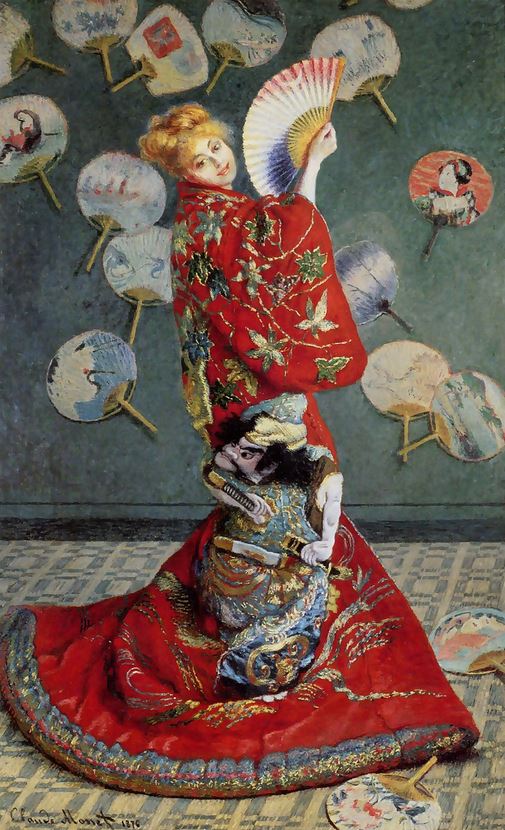by Patrick T. Reardon (March 2024)

La Japonaise
She’s large for a small woman when
you turn the corner at the Museum of
Fine Arts in Boston and there she is,
in her thick, luscious red, brightly
embroidered kimono, Monet’s first
wife Camille, just three years before
her death at 32, but looking quite
happy. Is she naked under there?
Under that thick, tactile fabric,
sporting a comically grim, cartoonishly
muscled, mustachioed samurai about
to draw his sword from its scabbard?
As a model, Camille is having fun
here, not like Victorine Meurent
with her straight-ahead challenge
of a stare in Manet’s Olympia, bare
except for her shoes and a black
ribbon around her neck, nor Pope
Innocent X who, chin-thick, glares
at Velazquez (and you and me),
plotting revenge, perhaps, or still
fuming about Oliver Cromwell and
the fate of Ireland — such are the
worries of a pontiff at the dawn of
the Age of Reason — and don’t even
ask what’s on that paper in his left
hand. He has, sitting there, five more
years to live; Victorine, half a century.
No portrait is being painted of me,
and I can’t tell you how many years I
have left. I know I won’t see my baby
grandson Noah turn forty. Or thirty.
Twenty, maybe. My friend Eunice
wrote the biography of Victorine, and
I can’t get enough of studying the
Velazquez Innocent on my computer
screen next to Francis Bacon’s take
on it, called his screaming Pope. I’ve
been to the Orangery Water Lillies
wall curves, and I’ve walked inside
Monet’s backyard paintings at Giverny,
but, listen, when I turn the corner at
the MFA, I get a jolt of joy each time
— you can see it on my face — to see
Camille again in her painting, seven
feet by five feet, in her fancy dress,
blond wig, pensive eyes and naked
smile, looking back perhaps at me.
Bomb
Bomb knows its logic,
each tick fits, slip by slip,
but body feels its art of wear and tear,
erasure and sudden snap, until finishment.
On the lawn,
the red-feather carcass of the cardinal, unwinged,
is otherwise untouched for the moment.
Sparrows flitter above
as if they would nest in my hair,
heat their eggs with my notions, peck my skull skin
as if in search of delicious sorrow seed.
The apostles and the elders
wrote a letter once about blood and impure meat,
but I know better than to expect a telegram
to explode at my doorway and send me shrapneling
into permanent orbit around the bovine sun,
a goofy smile on my face.
I eat salt with Satan, that dark angel of light,
while an agitated Elijah looks on,
wanting to thunder down the fire of heaven
and bragging that his angel wings
speed him twice as fast across the firmament
as the Angel of Death.
I hear a toddler’s footsteps
down the Halls of Heaven.
Book of hours
You have three metal bricks,
each a foot by a foot by a foot
— aluminum for irritation (170 pounds),
steel for sorrow (490 pounds),
lead for panic (710 pounds).
And, for agitation, a five-gallon
bucket of lard (38.5 pounds).
Patron of heavy weights, intercede.
You hunger a crowd of many numbers
to adulate, spotlight, fill the cavern
at the center of your earth.
Patron of lustful thoughts.
You buy the mechanism
that won’t work for you
— it works for anyone else —
and can search all you want for answers
without finding numbers that add up
to any language you can understand.
Intercede, patron of mosquito nests.
Under the basket, amid the rebounders,
you hold tight the ball as if it were
your entire life, a bomb near definition,
a gold egg from an unquickened womb,
more splendid than all the field lilies,
relic of the last nest of fire, a choir of
seraphim circling baptismal flame.
Patron of whiter than snow.
You open the unsterile door.
You conjure servants to ease your day
and maybe they go to work,
carrying your bricks and your bucket of lard.
Table of Contents
Patrick T. Reardon, a three-time Pushcart Prize nominee, is the author of six poetry collections including Salt of the Earth: Doubts and Faith and Puddin’: The Autobiography of a Baby, A Memoir in Prose Poems. His poetry has appeared in America, Rhino, After Hours, Heart of Flesh, Autumn Sky, Burningword Literary Journal, The Write Launch, Poetry East, The Galway Review, Under a Warm Green Linden and many other journals. His history book The Loop: The “L” Tracks That Shaped and Saved Chicago was published in 2020 by Southern Illinois University Press.
Follow NER on Twitter @NERIconoclast
- Like
- Digg
- Tumblr
- VKontakte
- Buffer
- Love This
- Odnoklassniki
- Meneame
- Blogger
- Amazon
- Yahoo Mail
- Gmail
- AOL
- Newsvine
- HackerNews
- Evernote
- MySpace
- Mail.ru
- Viadeo
- Line
- Comments
- SMS
- Viber
- Telegram
- Subscribe
- Skype
- Facebook Messenger
- Kakao
- LiveJournal
- Yammer
- Edgar
- Fintel
- Mix
- Instapaper
- Copy Link






